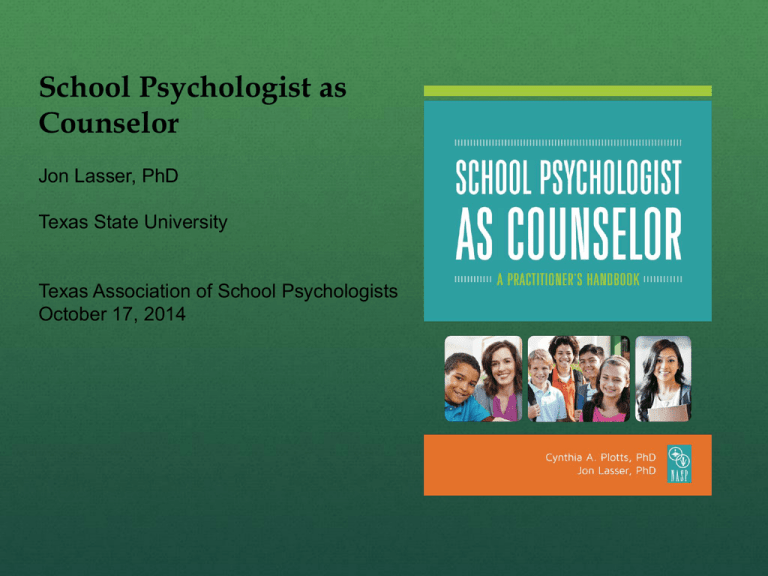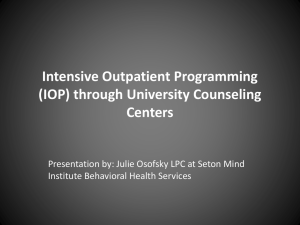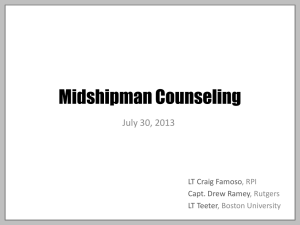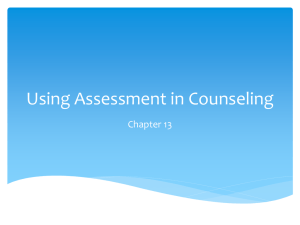Developing High-Quality Counseling IEPs
advertisement

School Psychologist as Counselor Jon Lasser, PhD Texas State University Texas Association of School Psychologists October 17, 2014 Objectives 1.To present different counseling approaches for use in the school setting. 2.To provide participants with strategies for integrating counseling in the IEP process. 3.To outline strategies for treatment and evaluating progress toward counseling goals. Who Are You? Do you have a counseling role in your district? Percentage time? Elementary, Secondary, Multiple? What is your comfort level with counseling? Your Presenters Jon Lasser (Cindy Plotts) Texas State University School Psychology Program Considerations for Counseling in Schools Constraints Advantages Preparation/Competence for Counseling by LSSPs Constraints Educational need ARD input Measurable outcomes/data-based Specific time frame Multiple relationships Advantages Naturalistic environment for observation and generalization Parents not charged Teacher consultation Can be supported by parent, teacher, administrator consultation Preparation/Competence Graduate training Experiences in school practice Theoretical/Empirical Grounding Limitations/Concerns Background Perceived need for a counseling resource designed for the unique role of the school psychologist Theoretical foundation, but also practical Conceptually rooted in a link between assessment and intervention Model for School-Based Counseling Model for School-Based Counseling Child Oriented Legal/Procedural Theoretical Child Oriented A place of trust and safety in school Reinforce and support other school missions Provide resources for self-help, self-direction, and self-regulation Develop empathy through experiences of active listening and positive regard Capacity building, bolstering social capital Why Counseling? All people communicate. Our goal is to facilitate and “unblock” communication so that it is productive. All people have problems and strengths and want to be heard and validated. Active listening (to verbal communication) and tracking (of nonverbal communication) are powerful techniques. All individuals have a cultural background and history that will affect interpretation of behavior and choice of intervention. From Child Oriented to Legal/Procedural Maintain a child oriented focus in spite of the legal and procedural requirements Comply with IDEA requirements Follow related service procedures Developing High-Quality Counseling IEPs Compliance with IDEIA 2004 First think broadly Social Emotional Behavioral Then write a broad annual goal Courtesy Kayla Jones, TX State University Related Service Counseling See Federal Register, V. 71, No. 156, Monday, August 14, 2006 Related services means…services as are required to assist a child with a disability to benefit from special education and includes… psychological services… counseling services… Related Service Counseling Related services also include… parent counseling and training. Counseling services means services provided by qualified social workers, psychologists, guidance counselors, or other qualified personnel. Parent Counseling/Training Assisting parents in understanding the special needs of their child Providing parents with information about child development Helping parents to acquire the necessary skills that will allow them to support the implementation of their child’s IEP Psychological Services Administering… tests and other assessment procedures Interpreting assessment results Obtaining, integrating, and interpreting information about child behavior and conditions related to learning Consulting with other staff members… to meet the special education needs of children as indicated by … evaluations More Psychological Services Planning and managing a program of psychological services, including psychological counseling for children and parents Assisting in developing positive behavioral intervention strategies Context Instructional Services Resource, reading program, specialized instruction, etc. Various Related Services OT, Counseling, PT, etc. What is Counseling as a Related Service? Recall that IDEIA is vague on the subject. Essentially, it a service (or set of services) provided to address social, emotional, and behavioral functioning in an effort to assist a child to benefit from special education. Purpose of Counseling as a Related Service? Ultimately, the purpose of counseling is dismissal from counseling. Short term goals and objectives will move us in the direction of dismissal. Overview of Steps Chapter 7 (The Counseling Process) and Chapter 8 (Working with Teams and Systems) Referral, assessment, IEP Development, consent, intervention, progress monitoring, dismissal Guidance For the IEP Team See handout “Developing Goals for Behavioral, Social, and Emotional Concerns ” for small group activity Referral Referral should ideally be an extension of the RTI process Are there good Tier I practices in place? Referral for related services should ask specific questions. Does X need counseling to be successful in school? Does X have competencies to make counseling beneficial? If counseling is indicated, what are the goals? (Note: don’t put the cart before the horse!) Assessment for Counseling FIE and RTI Referral Archival data Interviews Sample Assessment for Review IDEIA 2004 Requirements PLAAFP (¡Salud!): Present Levels of Academic Achievement and Functional Performance Statement of child’s present level of functioning: How the child’s disability affects the child’s involvement and progress in the general education curriculum Present Level of Functioning Suzie’s frequent anger outbursts and difficulty getting along with peers have a significant negative impact on her academic progress and development of socialization skills. She has a strong desire to please adults and is motivated to improve her social, emotional, and behavioral functioning. IDEIA 2004 Requirements Statement of measurable annual goals designed to: Meet the child’s needs that result from the child’s disability to enable the child to be involved in and make progress in the general education curriculum and Meet each of the child’s other educational needs that result from the child’s disability IDEIA 2004 Requirements Annual goals must include: Description of how and when progress will be measured; A statement of the related service, based on peer-reviewed research to the extent practicable, to be provided to the child, or on behalf of the child, and a statement of the program modification or supports for school personnel that will be provided to enable the child to… IDEIA 2004 Requirements to enable the child to… Advance appropriately toward attaining the annual goals Be involved in and make progress in the general education curriculum and to participate in extracurricular activities Be educated and participate with other children with disabilities and nondisabled children in extracurricular activities Other Details Projected date for the beginning of the services and modifications Anticipated frequency, location, and duration Not in IDEIA, but we recommend a projected end date. Key Pieces of the Counseling IEP What are the child’s unique needs? What services will the school employ to address each need? What will the child be able to accomplish as a result of the services? An Individualized Approach There’s no “one size fits all” for counseling IEP goals are informed by assessment data There are many ways to make progress on any given goal Measurable Annual Goals for Scott Scott will make measurable progress in the area of social functioning. And/Or Scott will make measurable progress in the area of emotional functioning. And/Or Scott will make measurable progress in the area of behavioral functioning. IEP Goals and Objectives Start with one or more of the broad annual goals. Write individualize objectives that move the student’s functioning in the direction of the goals. Include mastery criteria. Be specific. Example Annual Goal: Alex will make measurable progress in the area of social functioning. Objectives: Alex will demonstrate improved peer interactions in the classroom (3/5 peer interactions positive) Evaluated by counselor/teacher observation, individualized rating form, self-report Bank of Goals and Objectives There’s nothing wrong with developing a district bank of goals and objectives Must be sure to individualize for each student Mastery criteria ought to be established from baseline data Progress Monitoring Data collected collaboratively by LSSP and teacher measuring the specific objectives in the IEP Reported as an IEP progress report every 9 weeks Mastery criteria adjusted as data indicate what’s working and what isn’t Data also informs consultation efforts Dismissal Data-based decision ARD committee decision Ultimately the goal Supported Definition of a Problem A problem is a gap between what someone is doing and what is expected. Jerome complies with 1/5 requests. Teacher would like Jerome to comply with 5/5 requests. Do we need to meet in the middle? Determining Appropriateness of the Intervention The ARD committee should consider a number of factors before adding counseling as a related service. A structured format (provided) can facilitate the process of making these decisions Consider a tiered approach. Progress Monitoring We’re required to monitor and report on counseling progress. Emphasis should be placed on data Several tools can be used: Counselor-made measures PNRTs Criterion-referenced measures Counselor-Made Measures Can be individualized to match IEP goals and objectives Completed by teachers, parents, students, etc. Can be informed by other sources of data (e.g., observations, behavior frequency counts, etc.) PNRTs Provide a normative basis Typically not sensitive to small changes, although exceptions exist (some adaptive behavior scales) May have better reliability Criterion-Referenced Measures What if a school developed criteria for social, behavioral, and emotional success? Skills and sub-skills enumerated Clear criteria and cut scores Could be used as an indicator of counseling progress Always link progress to IEP Regardless of the method(s) used, progress should always be framed in terms of the IEP goals and objectives. Progress reporting should be data driven as well as narrative. Example of Progress Report Goal/Objective Goal: Alex will make measurable progress in the area of behavioral functioning. Objective: Demonstrate productive behavior in academic situations by increasing task completion (90%). Progress report: Alex was seen for six counseling sessions this reporting period. Consultation with teachers and his mother played an instrumental role in monitoring and modifying his behavior. He has demonstrated greatly improved coping strategies and significant gains in assignment completion (85%). Negotiating the Details Direct vs. Indirect Importance of Consultation Parent Training/Counseling Individual vs. Group Frequency, duration, etc. Documentation Considering Individual vs. Group Intervention Severity of emotional/behavioral interference Interpersonal relating/capacity to listen & share Ability to adhere to group ground rules Specific situational issues (e.g., divorce, grief) that lend themselves to group intervention. Counseling Activities: Questions to Guide Choices What is the child’s developmental level, especially verbally and cognitively? What is the trust level? Is there a specific presenting problem? Are supportive resources (parents, teachers) available to implement strategies? Is immediate change necessary for the child’s safety or well-being? Low Cognitive/Verbal Level Students Behavioral Techniques to foster consistent environmental structure, behavioral expectations, and consequences (consider consultation) Behavior contracts/charts to document and reinforce progress. Tangible rewards effective. Low verbal demand art/play activities to build sense of safety and alternatives to verbal communication Focus on relationship: reliability, acceptance, respect and fun High Cognitive/Verbal Student Cognitive-Behavior Techniques Reality Therapy Rational-Emotive Behavior Therapy Group Interventions Solution oriented, motivational interviewing High Cognitive/Low Verbal Activities with low verbal demand, minimal performance expectations, symbolic representation, e.g., sandtray, art activities Social modeling Psychoeducational approaches Bibliotherapy Techniques Problems are addressed with interventions. Interventions are selected based on client and counselor variables. Nondirective Approaches Unconditional positive regard Nondirective play therapy (warmth, genuineness, tracking, reflection, tolerance of low structure, theme and metaphor recognition) Person-Centered counseling (congruence of ideal and real selves, relationship of primary importance Semistructured Play/Activity Techniques (often Gestalt) Art activities with prompts (KFD, Collage, Timeline, Scribble Art) Clay activities (e.g., something about you) Bibliotherapy Mutual Storytelling Therapeutic use of games Sandtray Sandtray (Your World) Structured Techniques Reality Therapy (problem & solution oriented, verbal skills, ability to recall, think ahead & recognize options, practice & feedback) Cognitive-Behavioral Techniques (recognition and expression of thoughts and feelings, developing self-monitoring and selftalk, use of environmental contingencies) Positive Psychology Behavioral Approaches (clear problem identification, collecting of baseline data, collaborating with other caretakers, environmental engineering, contracting) Special Applications: Anxiety reduction (systematic desensitization), Relaxation training (progressive relaxation, imagery), Mindfulness Cognitive Therapy Basic Principles Client is understood in terms of his/her current thinking and its impact on feelings and behaviors What’s the relationship between thoughts, feelings, and behaviors? Basic Principles The foundation is a strong therapeutic alliance warmth, caring, empathy, trust Basic Principles The technique requires collaboration and active participation. Teamwork, partnership, working together. Gradual transition to increasingly active client. Basic Principles Goal oriented and problem focused. What are your problems, goals, and obstacles? Basic Principles Initial emphasis is on the present. Here and now. Therapist examines past experiences selectively when indicated. Basic Principles CBT is educative. Teach the client to be his/her own therapist, teach the method, prevent relapse. Basic Principles It’s a time-limited therapy. 4-14 sessions to provide symptom relief and avoid relapse. Basic Principles Structured sessions. Mood check Brief review of the week Collaboratively set agenda Feedback from previous session/HW review Discuss agenda items Assign homework Summarize/feedback Basic Principles Teach clients to identify, evaluate, and respond to their dysfunctional thoughts and beliefs. Socratic questioning & Collaborative empiricism Have you ever had this happen to you before? What did you do that time? What advice would you give to a friend in this situation? (Padesky, 1993) Cognitive Conceptualization Situation leads to Automatic Thought (from core belief) Leads to Emotion and Behavior Cognitive Conceptualization Thinking about tomorrow’s math test leads to automatic thought: “I won’t make it through the course” (derived from core belief: I’m inadequate) Leads to feeling sad and little to no effort studying thinking errors All or nothing “If I’m not a total success, I’m a failure” Catastrophizing “I’ll be so upset, I won’t be able to function at all” Discounting the positive “I did that project well, but only because I got lucky” thinking errors Emotional reasoning Ignore the evidence and focus on feelings “I know I do things ok, but I feel like a failure” Labeling “I’m a looser” Magnify/Minimize “Getting good grades doesn’t mean I’m smart” “My adequate evaluation means I’m no good” thinking errors Mental filter “That one low score on my job evaluation means I’m no good” Mind reading “He thinks I don’t do anything right” Overgeneralization “I felt awkward at the dance, so I don’t have what it takes to make friends” thinking errors Personalization “The waiter was curt to me because I did something wrong” Imperatives “I shouldn’t make mistakes” or “I must always be successful” Tunnel Vision “The other kids are mean and insensitive (failure to see any positives) Situation AT and % belief Emotion Studying for exam I’ll never Anxious learn this. Sad I’m stupid 80% Adaptive Outcome response New belief What’s the % in AT. evidence New that the AT emotion or is true? change in Is there intensity. another What will explanatio you do? n? What’s the worst that could happen? What’s the effect Choice Theory & Reality Therapy: William Glasser He was a board-certified psychiatrist Famous (or infamous) for never prescribing meds for clients Creator of Choice Theory and Reality Therapy Started teaching it in 1965 Passed away August, 2013 Choice Theory A psychological theory for understanding human behavior Is the over-arching theory within which reality therapy resides Formally called Control Theory (some problems with that) Central tenants include: That all we do is behave Almost all behavior is chosen (internally controlled & motivated) All behavior that we chose is to satisfy 5 basic, genetically-programmed needs Survival (the physiological need) Love & belonging Power Freedom Fun Locus of control is central to choice theory 5 Basic Needs 1. Survival (the only physiological need): food, water, shelter, sleep, elimination, sexuality Four psychological needs are: 2. Love & Belonging: be with & relate to others; share, join, & have relationships with others 3. Power: gain importance, recognition, & achieve competence 4. Freedom: move, choose, act, & think without restriction 5. Fun: learn, laugh, play, experience pleasure • The need that is satisfied least drives our behavior the most Can you think of a need that doesn’t fit into one of these categories? Love & Belongingness as the Most Important Need It is the most important need bc we need people to satisfy the other needs Based on choice theory, clients are choosing their behavior in an attempt to deal with the frustration caused by unsatisfying relationships The therapeutic relationship is so critical bc when a client comes to you, it is most likely that they are in distress because the belongingness/love need is not being satisfied The Quality World Shortly after birth throughout the rest of our lives, we begin storing information about what feels very good to us They become specific pictures in our heads of the things that meet our basic needs This is our personal Shangri-la & it is the world that we would live in if we could Take Inventory of Your Quality World Mental Illness According to Dr. Glasser Mental illness, for the most part, represents a choice (sometimes a very creative choice) to deal with the frustrated needs that are in our quality world Very few mental illnesses can be attributed to brain anomalies (Alzheimers) Prove it! Total Behavior All behavior is made up of 4 inseparable but distinct components: 1. Acting 2. Thinking 3. Feeling 4. Physiology Focus of RT is acting & thinking bc we can control those Main difference between CBT & RT: It is easier to act your way into a different way of thinking than to think your way into a different way of acting Depressed vs. Depressing Role of Feelings Feelings are like a barometer of how well we are satisfying our needs within our quality world When we feel, sad, angry, frustrated, etc., the root will be a need within our quality world that is being unmet Most likely, the client is not satisfied with one or more interpersonal relationships Reality Therapy A counseling technique established by Dr. Glasser to help us choose more effective behavior. Goal is to help counselees take ownership of their behavior & responsibility for directions in their lives The Therapist’s Relationship with Clients Try to get into the client’s quality world Through the relationship with the therapist, the client learns how to get close to the people they need Need to establish a trusting relationship so that you can teach the client choice theory Want the client to replace external control psychology (which is a source of much frustration) with choice theory Characteristics of an Effective Reality Therapist Be involved in good relationships yourself Able to interact with a wide variety of people comfortably Be open & accepting Have your finger on the pulse of popular culture Have a large repertoire of successful life experiences Most important characteristic: be in better shape than the client (particularly in areas that the client is not effective) Primary Components of R.T. The counseling environment Build a close relationship built on TRUST & HOPE through friendliness, firmness, & fairness Need to develop a strong, therapeutic relationship that includes empathy Discuss problems in the past tense, solutions in the present & future tenses Don’t argue, boss, manage, blame, criticize, encourage excuses, demean, instill fear Stress what they CAN control, accept them as they are, & keep confidence that they will develop more effective behaviors The procedures that lead to change Use the WDEP system The WDEP System Wants – What do you want? What do you want to have happen? How do you want this to turn out? Doing – What are you doing? (Actions, thinking, feeling). Don’t ask why…ask what Evaluation – Is it helping you? Is it working for you? Is it getting you want you want? Is it effective? Plan – What’s your plan? What are you going to do? Empirically-Validated Interventions Research readings and reviews should supplement techniques books (like Oaklander) Always look at the samples and controlled variables in studies: how generalizable are the results? Can I replicate the conditions in the study? Are my clients similar to those in the study? With meta-analyses, consider that data collapsed across studies may mask individual differences and responsiveness; case studies are also valuable Specific Interventions Theory/Techniques/Empirical Support Depression: CBT, IPT, ACTION (Stark), CWDA (ages 12-18) Coping With Depression-Adolescents Manual and Workbook Anxiety: Coping CAT (ages 7-13 plus adolescent version) (Kendall, Furr, Podell, 2010) Impulsivity Aggression: Anger management program from SAMHSA, multisystemic approaches most effective CASEL SAMHSA Eclectic Counseling Model Person-Centered Active Listening Empathy Unconditional Positive Regard Play, Sand Tray, Open-Ended Art Therapy, KFD, Fingerpaint, Scribble Art Gestalt Therapy, Fantasy/Relaxation, Empty Chair, Top Dog/Underdog Cognitive, CBT, Reality Therapy, Rational-Emotive Group Counseling Advance preparation (needs assessment, group promotion and member selection, # sessions, activities/curriculum, evaluation) Leadership skills (ground rules, ice breakers, go rounds, linking, drawing out, cutting off) and getting coleader if possible Multicultural considerations (ethnicity, homogeneous/heterogeneous, self-disclosure, social behaviors, etc.) UNIVERSALITY & SAFETY Crisis Intervention: KNOW YOUR SCHOOL DISTRICT AND CAMPUS PLAN Many types of crises, both individual and group Willingness to help, be involved, plan Collection of readily available materials for suicide assessment, postvention, connection to resources in community, documentation of contacts Considerations of privacy vs. safety Crisis Counseling People react differently to crises: meet them where they are Respect cultural differences in involving outsiders, grieving process, rituals Consider developmental levels in understanding of death and loss Recognize that teachers/staff grieve too Be prepared to follow up at a later date Family Considerations Take advantage of the opportunities we have to involve families: interviews, ARDS Recognize that all behavior occurs in the context of dynamic and interdependent systems Use active listening and group management techniques to facilitate effective family-school collaboration Multicultural Considerations Metatheory—no theory right or wrong Individual, group, and cultural contexts must all be considered Cultural identity development integral Counseling is only one of the helping roles Self-study, consultation and supervision essential for competent multicultural practice Systemic framework, solution-oriented, ideographic approaches recommended Transition Related Services to General Education Counseling Concluding Counseling/Generalization Resources The California Evidence-Based Clearinghouse for Child Welfare www.cebc4cw.org Counseling with Drug-Abusing Youth* *adapted from NASP webinar presented by Ken Winters, Ph.D. on Nov. 6, 2013 Basic Principles Develop a strong yet caring relationship Help him or her to break the functional value of the drug use Abstinence is ideal but may need behavioral shaping towards that goal Harmful consequences exist on a continuum (harm reduction, risk reduction) Counseling for Substance Abuse Techniques Brief Intervention (up to 8 sessions; 2-4 typical) Motivational Interviewing (person-centered, not confrontational) Most effective with use/abuse rather than addiction Motivational Interviewing EE—Express Empathy AA—Avoid Arguing RR—Roll with Resistance (reframe) SS—Support Self-Efficacy DD—Develop Discrepancy (present and future) Decisional Balance (Pro-Con Exercise) What are the pros of the adolescent’s drug use? What are the cons (negatives) of the adolescent’s drug use? Evidence-Based Approaches SAMHSA National Registry of Evidence Based Programs and Practices Case Examples “Jake” Jake is a 4th grade student who transferred in from another state. Although his records were incomplete, documentation clearly indicated that he had been receiving special education services for speech only. Initial Concerns His ARD committee meets and decides to start Jake with his speech-only services, but after his first day of classes, his teacher contacts the school psychologist with the following concerns: -Jake did not interact with any of his classmates -He refused to leave the classroom when it was time to go to specials -He rarely participated, but when he did, he responses were odd, off-topic, and frequently involved the topic of sharks. Request for more data -Clinical interview with parents and Jake -Cognitive measures -Achievement measures -Social/emotional measures -Observations across settings -Behavior rating scales (broad spectrum -Adaptive behavior assessment -Autism rating scales Behavioral Observations Initially, Jake was compliant when the school psychologist began the assessment. He answered questions in such a way that demonstrated good receptive language skills, but he occasionally refused to respond to some inquiries. The examiner noted some unusual prosody (Jake spoke with a “sing-songy” voice) and Jake’s persistent way of steering the conversation on to the topic of sharks. The cognitive assessment was initially successful, but later became difficult. The first few subtests indicated very strong cognitive abilities, and Jake appeared to be comfortable with the testing. However, he became very frustrated with some of the teaching items, perhaps because he found them to be unnecessary. At this point, he refused to participate and was sent back to class. Two more attempts were made to complete the cognitive assessment, but he refused both times. Similarly, Jake refused the achievement tests. Results Behavior rating scales and adaptive behavior scales were completed by Jake’s parents and teachers and indicated deficits in social and communication skills, some atypicality, and externalizing behaviors. The autism rating scales suggested the possibility of an autism spectrum disorder. Utilizing multiple sources of data, the school psychologist, in collaboration with the multidisciplinary team, determined that Jake met the criteria for an autism spectrum disorder. Eligible for Counseling A counseling eligibility report was developed, utilizing the data from the FIE as its primary source. Additional data were gathered to inform the goal and objective development, including some baselines for behaviors of concern. Additionally, Jake’s counseling competencies were identified (e.g., motivation to change, capacity to work with a caring adult, etc.). The school psychologist drafted IEP goals and objectives and shared them with Jake’s parents and teachers 5 days before the ARD. At the ARD, the goals and objectives were slightly modified and finalized Goals and Objectives Jake will make measurable progress in the area of social functioning, as evidenced by: -Jake initiating social interaction with peers with teacher prompting (at least twice per day with one prompt per interaction). -Jake making appropriate (on-topic) contributions to peer conversations (50% of his contributions on-topic). Jake will make measurable progress in the area of behavioral functioning, as evidenced by: -Compliance with teacher request to transition to specials (3/4 times compliant). Intervention The ARD committee recommended 60 minutes/week of counseling (30 minutes individual and 30 minutes group), as well as consultation with parents and teachers. The following interventions were put in place: 1. Parent-teacher CBC facilitated by LSSP to develop some consistency across settings. 2. Individual counseling with a social skills training focus to rehearse and practice appropriate social conversations. 3. Group sessions with typically developing, non-referred students as well as other students on the spectrum to increase generalization and promote interaction. Case Study: “Jenna” See Handout Discuss Thank You! We look forward to continued discussion!








